Impacts of Inter-Basin Water Transfer Projects on Optimal Water Resources Allocation in the Hanjiang River Basin, China
Abstract
:1. Introduction
2. Study Area and Data
2.1. Water Transfer Projects in the Hanjiang River Basin
2.2. Study Area
2.3. Data
3. Methodology
3.1. Description of Scenarios
3.2. Water Demand Projection Module
3.2.1. Water Demand of the Socio-Economic Sectors
3.2.2. Water Demand of the In-Stream Ecological Sector
3.3. Optimization of the Water Resources Allocation Model
3.3.1. Objective Functions
3.3.2. System Constraints
3.3.3. Optimization Algorithm
3.4. Evaluation Criteria
3.4.1. Reliability of Water Supply
3.4.2. Vulnerability of Water Supply
3.4.3. Resilience of Water Supply
4. Results and Discussion
4.1. Water Demand in 2020 and 2030
4.2. Impacts of Inter-Basin Water Transfer Projects on the Optimal Water Resources Allocation
4.2.1. Impacts of Inter-Basin Water Transfer Projects on the Results of Optimal Water Resources Allocation
4.2.2. Performance of Evaluation Criteria from the Inter-Basin Water Transfer Projects
5. Conclusions
Author Contributions
Funding
Acknowledgments
Conflicts of Interest
References
- Gupta, J.; Zaag, P.V.D. Interbasin water transfers and integrated water resources management: Where engineering, science and politics interlock. Phys. Chem. Earth 2008, 33, 28–40. [Google Scholar] [CrossRef]
- Cosgrove, W.J.; Loucks, D.P. Water management: Current and future challenges and research directions. Water Resour. Res. 2015, 51, 4823–4839. [Google Scholar] [CrossRef] [Green Version]
- Kerachian, R.; Karamouz, M. A stochastic conflict resolution model for water quality management in reservoir–river systems. Adv. Water Resour. 2007, 30, 2866–2882. [Google Scholar] [CrossRef]
- Eliasson, J. The rising pressure of global water shortages. Nature 2015, 517, 6. [Google Scholar] [CrossRef] [PubMed]
- Sheffield, J.; Wood, E.F. Projected changes in drought occurrence under future global warming from multi-model, multi-scenario, IPCC AR4 simulations. Clim. Dyn. 2008, 31, 79–105. [Google Scholar] [CrossRef]
- Feng, S.; Li, L.X.; Duan, Z.G.; Zhang, J.L. Assessing the impacts of south-to-north water transfer project with decision support systems. Decis. Support Syst. 2007, 42, 1989–2003. [Google Scholar] [CrossRef]
- Yong, P.; Jinggang, C.; Anbang, P.; Huicheng, Z. Optimization operation model coupled with improving water-transfer rules and hedging rules for inter-basin water transfer-supply systems. Water Resour. Manag. 2015, 29, 3787–3806. [Google Scholar]
- Shang, Y.; Xue, J.; Wang, S.; Yang, Z.; Yang, J. A case history of Tunnel Boring Machine jamming in an inter-layer shear zone at the Yellow River Diversion Project in China. Eng. Geol. 2004, 71, 199–211. [Google Scholar] [CrossRef]
- Gu, W.; Shao, D.; Jiang, Y. Risk evaluation of water shortage in source area of middle route project for south-to-north water transfer in China. Water Resour. Manag. 2012, 26, 3479–3493. [Google Scholar] [CrossRef]
- Hong, X.J.; Guo, S.L.; Wang, L.; Yang, G.; Liu, D.D.; Guo, H.J.; Wang, J. Evaluating water supply risk in the middle and lower reaches of Hanjiang River basin based on an integrated optimal water resources allocation model. Water 2016, 8, 364. [Google Scholar] [CrossRef]
- Zhang, Q.F.; Xu, Z.F.; Shen, Z.H.; Li, S.Y.; Wang, S.S. The Han river watershed management initiative for the south-to-north water transfer project (middle route) of China. Environ. Monit. Assess. 2009, 148, 369–377. [Google Scholar] [CrossRef] [PubMed]
- Davies, B.R.; Thoms, M.; Meador, M. An assessment of the ecological impacts of inter-basin water transfers, and their threats to river basin integrity and conservation. Aquat. Conserv. Mar. Freshwat. Ecosyst. 1992, 2, 325–349. [Google Scholar] [CrossRef]
- Zeng, Q.; Qin, L.; Li, X. The potential impact of an interk-basin water transfer project on nutrients (nitrogen and phosphorous) and chlorophyll a of the receiving water system. Sci. Total Environ. 2015, 536, 675–686. [Google Scholar] [CrossRef] [PubMed]
- Slabbert, N. The Potential Impact of an Inter-Basin Water Transfer on the Modder and Caledon River Systems. Ph.D. Thesis, University of the Free State, Bloemfontein, South Africa, 2007. [Google Scholar]
- Drinkwater, K.F.; Frank, K.T. Effects of river regulation and diversion on marine fish and invertebrates. Aquat. Conserv. Mar. Freshwat. Ecosyst. 1994, 4, 135–151. [Google Scholar] [CrossRef] [Green Version]
- Gibbins, C.N.; Soulsby, C.; Jeffries, M.; Acornley, R. Developing ecologically acceptable river flow regimes: A case study of Kielder reservoir and the Kielder water transfer system. Fish. Manag. Ecol. 2001, 8, 463–485. [Google Scholar] [CrossRef]
- Snaddon, C.; Davies, B. A preliminary assessment of the effects of a small South African inter-basin water transfer on discharge and invertebrate community structure. Regul. Rivers Res. Manag. 1998, 14, 421–441. [Google Scholar] [CrossRef]
- Day, J.; Bridger, K.; Peet, S.; Friesen, B. Northwestern Ontario River Dimensions; Wiley: Hoboken, NJ, USA, 1982. [Google Scholar]
- Zhai, S.; Hu, W.; Zhu, Z. Ecological impacts of water transfers on Lake Taihu from the Yangtze River, China. Ecol. Eng. 2010, 36, 406–420. [Google Scholar] [CrossRef]
- Li, M.; Fu, Q.; Singh, V.P.; Liu, D. An interval multi-objective programming model for irrigation water allocation under uncertainty. Agrc. Water. Manag. 2018, 196, 24–36. [Google Scholar] [CrossRef]
- Liu, D.D.; Chen, X.H.; Lou, Z.H. A model for the optimal allocation of water resources in a saltwater intrusion area: A case study in Pearl River Delta in China. Water Resour. Manag. 2010, 24, 63–81. [Google Scholar] [CrossRef]
- Hu, Z.; Wei, C.; Yao, L.; Li, C.; Zeng, Z. Integrating equality and stability to resolve water allocation issues with a multiobjective bilevel programming model. J. Water Resour. Plan. Manag. 2016, 142, 04016013. [Google Scholar] [CrossRef]
- Zhou, Y.L.; Guo, S.L.; Hong, X.J.; Chang, F.J. Systematic impact assessment on inter-basin water transfer projects of the Hanjiang River Basin in China. J. Hydrol. 2017, 553, 584–595. [Google Scholar] [CrossRef]
- Liu, D.D.; Guo, S.L.; Shao, Q.X.; Liu, P.; Xiong, L.H.; Wang, L.; Hong, X.J.; Xu, Y.; Wang, Z.L. Assessing the effects of adaptation measures on optimal water resources allocation under varied water availability conditions. J. Hydrol. 2018, 556, 759–774. [Google Scholar] [CrossRef]
- Changjiang Water Resources Commission. Report on the Comprehensive Management Plan on Water Resources for Hanjiang River Basin, China; Changjiang Water Resources Commission: Wuhan, China, 2011. (in Chinese) [Google Scholar]
- Hubei Provincial Department of Water Resources. Dispatching Schedules of Hubei Provincial Large Reservoirs; Hubei Provincial Department of Water Resources: Wuhan, China, 2014. (in Chinese) [Google Scholar]
- Brekke, L.; Larsen, M.D.; Ausburn, M.; Takaichi, L. Suburban water demand modeling using stepwise regression. J. Am. Water Works Assoc. 2002, 94, 65–95. [Google Scholar] [CrossRef]
- Tennant, D.L. Instream flow regimens for fish, wildlife, recreation and related environmental resources. Fisheries 1976, 1, 6–10. [Google Scholar] [CrossRef]
- Deb, K. A fast and elitist multiobjective genetic algorithm: NSGA-II. IEEE Trans. Evol. Comput. 2002, 6, 182–197. [Google Scholar] [CrossRef] [Green Version]
- Salazar, D.; Rocco, C.M.; Blas, J. Galván. Optimization of constrained multiple-objective reliability problems using evolutionary algorithms. Reliab. Eng. Syst. Saf. 2006, 91, 1057–1070. [Google Scholar] [CrossRef]
- Lotfan, S.; Ghiasi, R.A.; Fallah, M.; Sadeghi, M.H. ANN-based modeling and reducing dual-fuel engine’s challenging emissions by multi-objective evolutionary algorithm NSGA-II. Appl. Energy 2016, 175, 91–99. [Google Scholar] [CrossRef]
- Tabari, M.M.R.; Yazdi, A. Conjunctive use of surface and groundwater with inter-basin transfer approach: Case study Piranshahr. Water Resour. Manag. 2014, 28, 1887–1906. [Google Scholar] [CrossRef]
- Paul, A.K.; Shill, P.C. New automatic fuzzy relational clustering algorithms using multi-objective NSGA-II. Inf. Sci. 2018, 448, 112–133. [Google Scholar] [CrossRef]
- Cañón, J.; González, J.; Valdés, J. Reservoir operation and water allocation to mitigate drought effects in crops: A multilevel optimization using the drought frequency index. J. Water Resour. Plan. Manag. 2009, 135, 458–465. [Google Scholar] [CrossRef]
- Milano, M.; Ruelland, D.; Dezetter, A.; Fabre, J.; Ardoin-Bardin, S.; Servat, E. Modeling the current and future capacity of water resources to meet water demands in the Ebro basin. J. Hydrol. 2013, 500, 114–126. [Google Scholar] [CrossRef]
- Asefa, T.; Clayton, J.; Adams, A.; Anderson, D. Performance evaluation of a water resources system under varying climatic conditions: reliability, resilience, vulnerability and beyond. J. Hydrol. 2014, 508, 53–65. [Google Scholar] [CrossRef]
- Zhang, C.; Xu, B.; Li, Y.; Fu, G.T. Exploring the relationships among reliability, resilience, and vulnerability of water supply using many-objective analysis. J. Water Resour. Plan. Manag. 2017, 143, 04017044. [Google Scholar] [CrossRef]
- Chanda, K.; Maity, R.; Sharma, A.; Mehrotra, R. Spatiotemporal variation of long-term drought propensity through reliability-resilience-vulnerability based drought management index. Water Resour. Res. 2014, 50, 7662–7676. [Google Scholar] [CrossRef]
- Ajami, N.K.; Hornberger, G.M.; Sunding, D.L. Sustainable water resource management under hydrological uncertainty. Water Resour. Res. 2008, 44, 2276–2283. [Google Scholar] [CrossRef]
- Mendoza, V.M.; Villanueva, E.E.; Adem, J. Vulnerability of basins and watersheds in Mexico to global climate change. Clim. Res. 1997, 9, 139–145. [Google Scholar] [CrossRef] [Green Version]
- Asefa, T.; Wanakule, N.; Adams, A.; Shelby, J.; Clayton, J. On the use of system performance metrics for assessing the value of incremental water-use permits. J. Water Resour. Plan. Manag. 2014, 140, 04014012. [Google Scholar] [CrossRef]
- Hashimoto, T.; Loucks, D.P.; Stedinger, J.R. Reliability, resiliency, robustness, and vulnerability criteria for water resource systems. Water Resour. Res. 1982, 18, 14–20. [Google Scholar] [CrossRef]
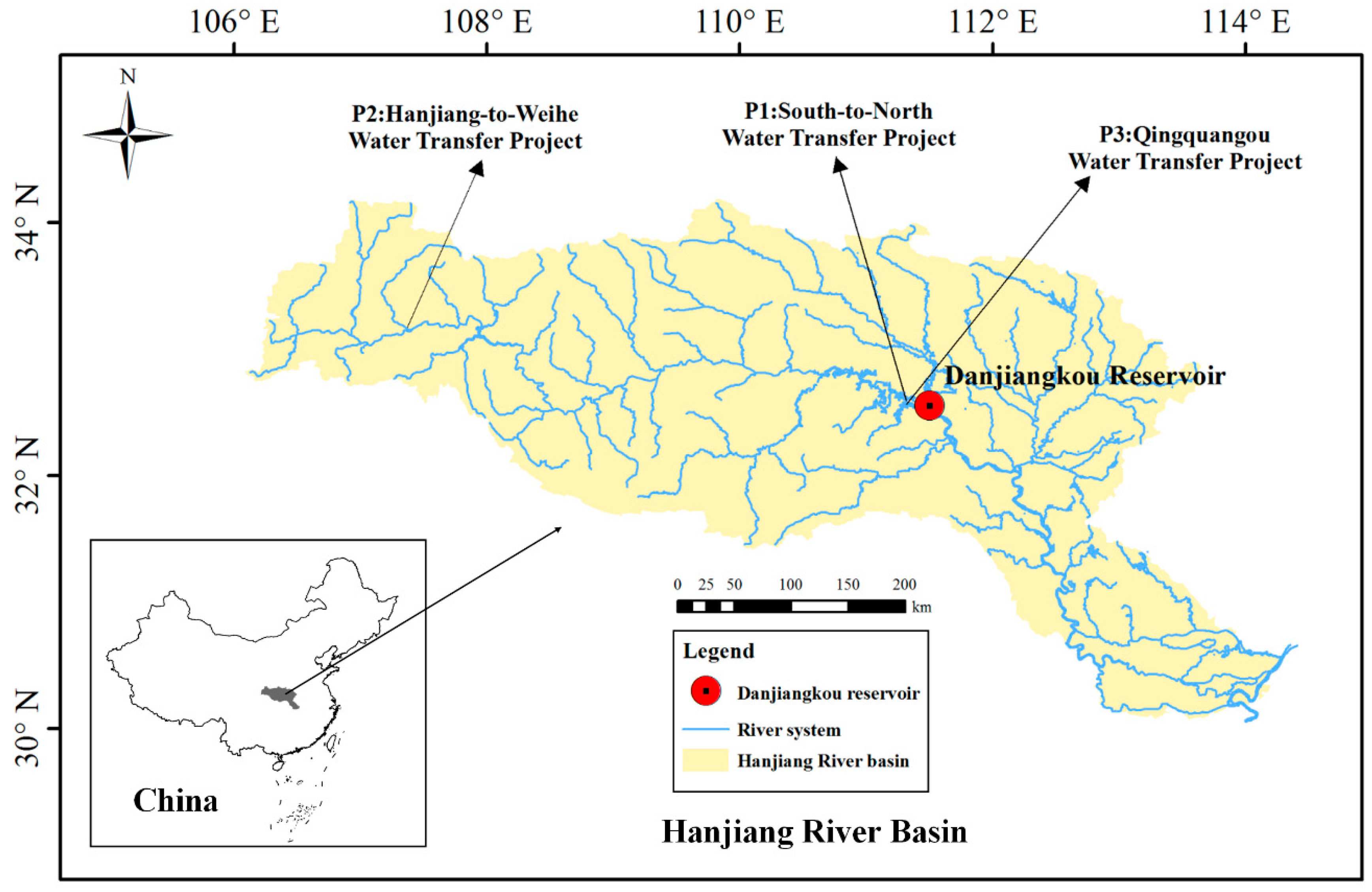

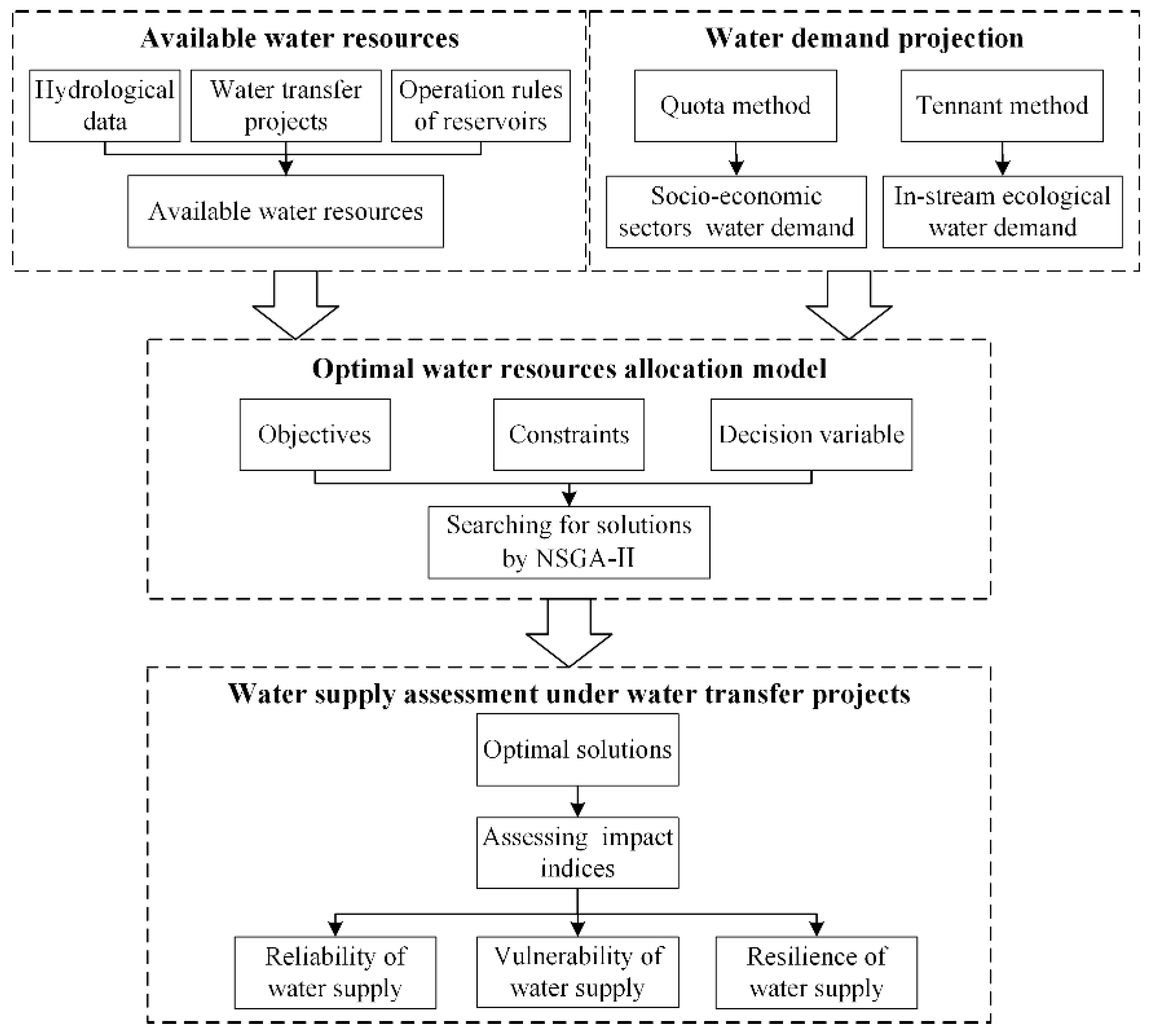


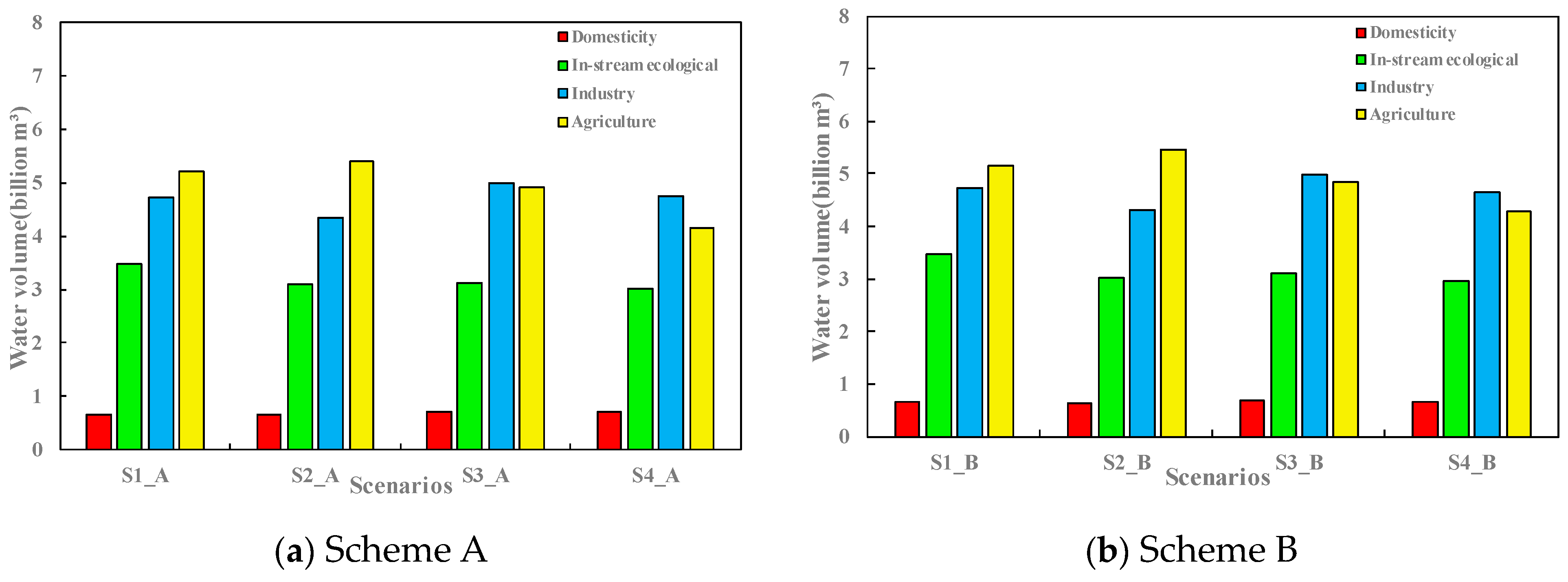
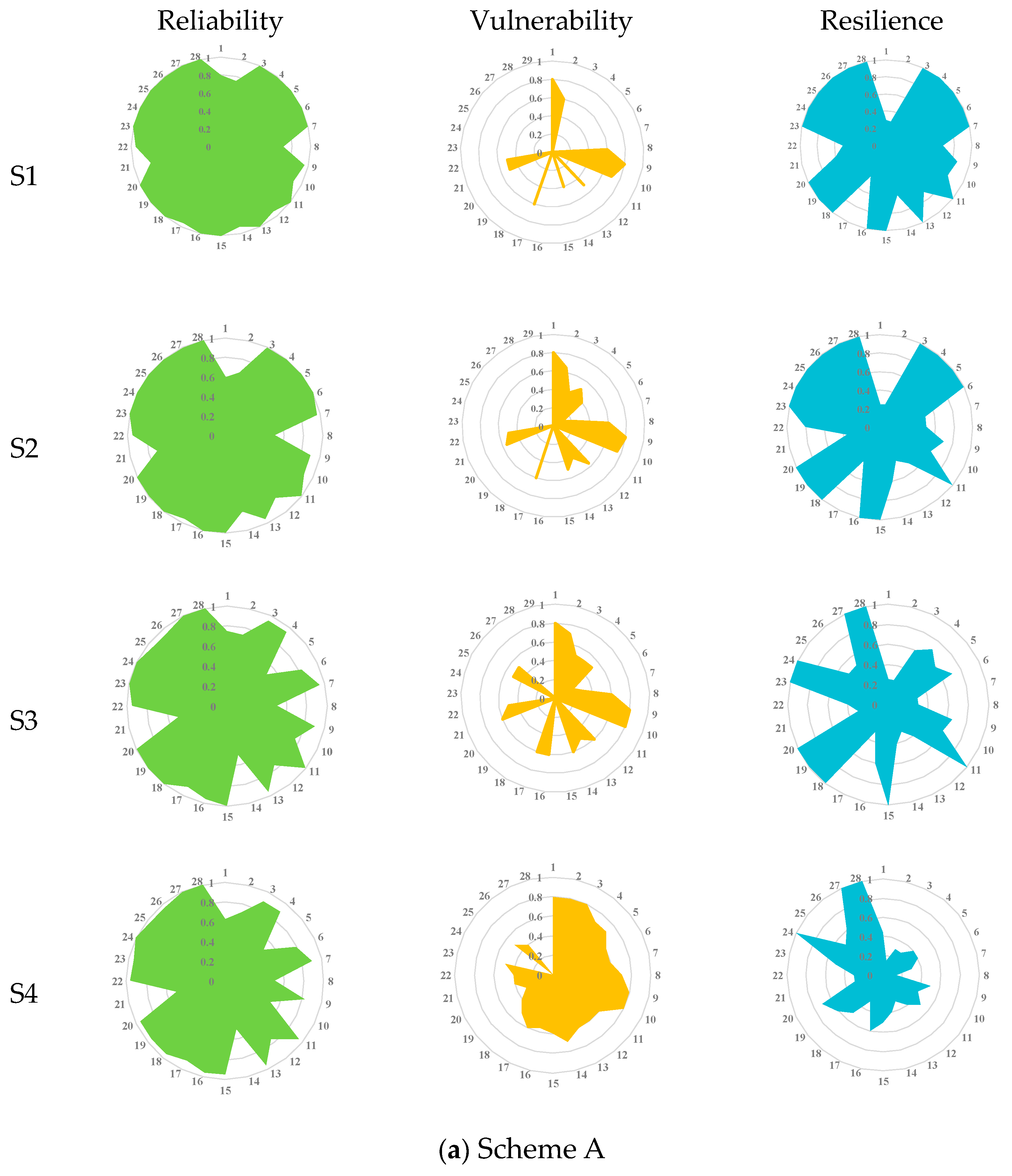
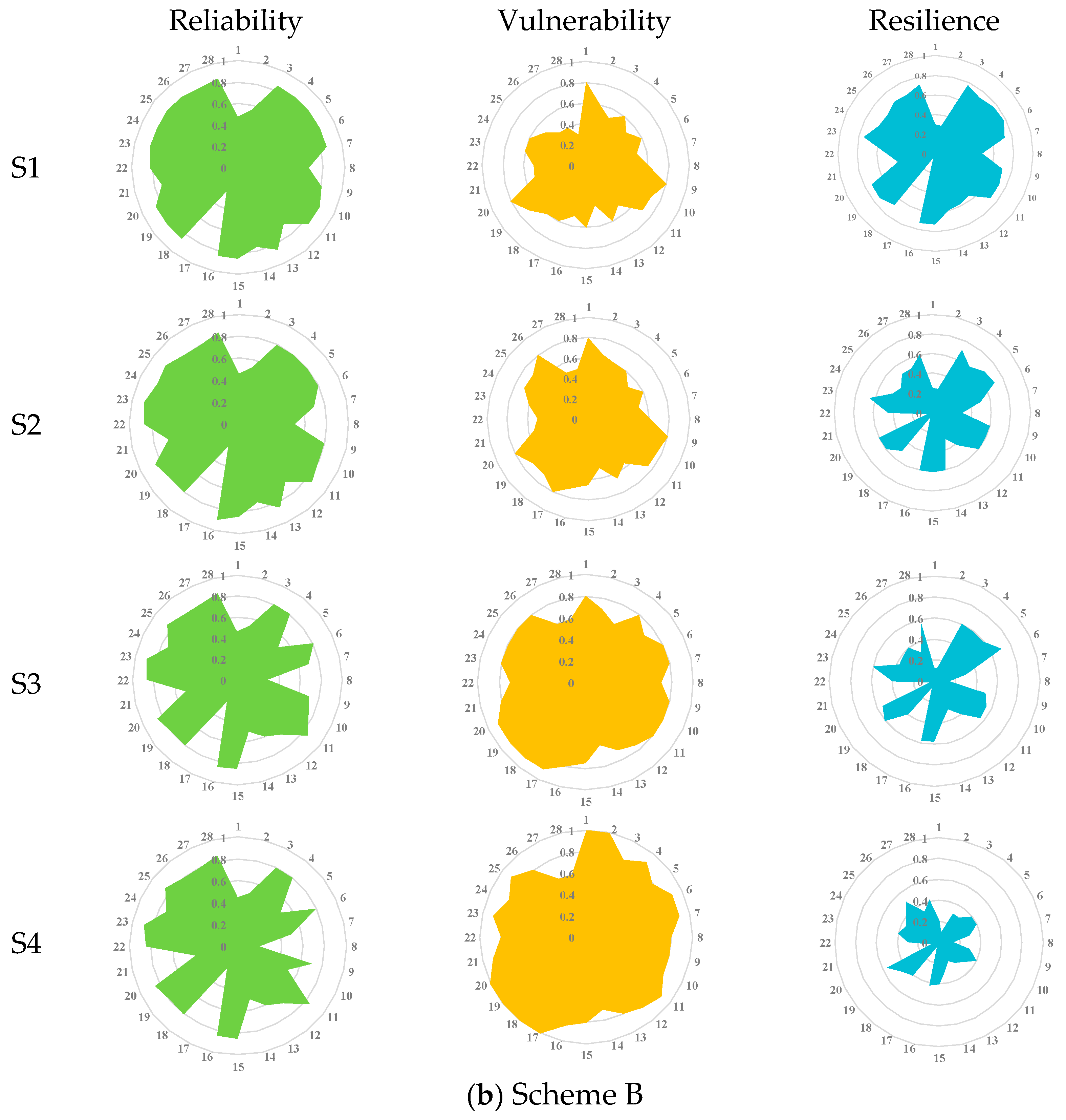
| Project Name | Water Resource | Water Receiving Area | Water-Use Category | Designed Annual Water Transfer Demand (billion m3) (Total/Inter-Basin 1) | |
|---|---|---|---|---|---|
| 2020 | 2030 | ||||
| P1 | Danjiangkou Reservoir | Henan Province, Hebei Province, Tianjin and Beijing Cities | Domestic, industrial and agricultural use | 9.5/8.5 | 13.13/12.05 |
| P2 | Huangjinxia Reservoir and Sanhekou Reservoir 2 | Xi’an, Xianyang, Baoji, Weinan and Yangling Cities | Ecological, domestic, industrial and agricultural use | 1/1 | 1.5/1.5 |
| P3 | Danjiangkou Reservoir | Xiangyang, Zhaoyang, Suizhou, Guangshui and Xiaogan Cities | Ecological, domestic, industrial and agricultural use | 0.628/0 | 1.398/0.291 |
| NO. | Reservoir | Total Storage (million m3) | Useful Storage (million m3) | Dead Storage (million m3) | Flood Limited Water Level (m) |
|---|---|---|---|---|---|
| 1 | Sanliping | 510 | 211 | 261 | 403/412 |
| 2 | Siping | 269 | 145 | 102 | 313.86 |
| 3 | Danjiangkou | 33910 | 21220 | 12690 | 160.0/163.5 |
| 4 | Mengqiaochuan | 110.33 | 88.15 | 2.7 | 142.2 |
| 5 | Huayanghe | 107 | 70.8 | 1.4 | 144.19 |
| 6 | Xionghe | 195.9 | 115.9 | 20 | 125 |
| 7 | Xipaizihe | 220.4 | 22 | 2.23 | 111.8 |
| 8 | Hongshuihe | 103.6 | 58.9 | 5.4 | 117 |
| 9 | Shimenji | 154.03 | 114.69 | 1.85 | 195 |
| 10 | Sandaohe | 154.6 | 127.42 | 0.02 | 154 |
| 11 | Yuntaishan | 123 | 89 | 5 | 163 |
| 12 | Yinghe | 121.66 | 76.31 | 3.62 | 132.7 |
| 13 | Huangpo | 125.61 | 70.25 | 10.1 | 76 |
| 14 | Wenxiakou | 520 | 269 | 176 | 105 |
| 15 | Shimen | 159.1 | 68.6 | 13 | 195 |
| 16 | Gaoguan | 201.08 | 154.32 | 30.89 | 118 |
| 17 | Huiting | 313.4 | 173.5 | 32.5 | 84.75 |
| Water Transfer Project | 2020 | 2030 | ||
|---|---|---|---|---|
| S1 | S2 | S3 | S4 | |
| P1 | / | 8.500 | 8.500 | 12.050 |
| P2 | / | 1.000 | 1.000 | 1.500 |
| P3 | / | 0.000 | 0.000 | 0.291 |
| Year | Domesticity | Industry | Agriculture (billion m3) | Off-Stream (billion m3) | ||||||
|---|---|---|---|---|---|---|---|---|---|---|
| (billion m3) | (billion m3) | P = 50% | P = 75% | P = 90% | P = 95% | P = 50% | P = 75% | P = 90% | P = 95% | |
| 2020 | 0.65 | 5.09 | 5.58 | 6.21 | 6.96 | 7.46 | 11.32 | 11.95 | 12.70 | 13.20 |
| 2030 | 0.87 | 6.57 | 5.09 | 5.64 | 6.26 | 6.74 | 12.53 | 13.07 | 13.69 | 14.18 |
| Scenarios | Schemes | OF1 (billion m3) | OF2 (104 tons) |
|---|---|---|---|
| S1 | A | 2.123 | 22.216 |
| B | 2.160 | 20.721 | |
| S2 | A | 2.698 | 21.625 |
| B | 2.721 | 20.855 | |
| S3 | A | 3.216 | 22.200 |
| B | 3.228 | 21.485 | |
| S4 | A | 4.259 | 22.107 |
| B | 4.335 | 20.269 |
© 2019 by the authors. Licensee MDPI, Basel, Switzerland. This article is an open access article distributed under the terms and conditions of the Creative Commons Attribution (CC BY) license (http://creativecommons.org/licenses/by/4.0/).
Share and Cite
Tian, J.; Liu, D.; Guo, S.; Pan, Z.; Hong, X. Impacts of Inter-Basin Water Transfer Projects on Optimal Water Resources Allocation in the Hanjiang River Basin, China. Sustainability 2019, 11, 2044. https://doi.org/10.3390/su11072044
Tian J, Liu D, Guo S, Pan Z, Hong X. Impacts of Inter-Basin Water Transfer Projects on Optimal Water Resources Allocation in the Hanjiang River Basin, China. Sustainability. 2019; 11(7):2044. https://doi.org/10.3390/su11072044
Chicago/Turabian StyleTian, Jing, Dedi Liu, Shenglian Guo, Zhengke Pan, and Xingjun Hong. 2019. "Impacts of Inter-Basin Water Transfer Projects on Optimal Water Resources Allocation in the Hanjiang River Basin, China" Sustainability 11, no. 7: 2044. https://doi.org/10.3390/su11072044





